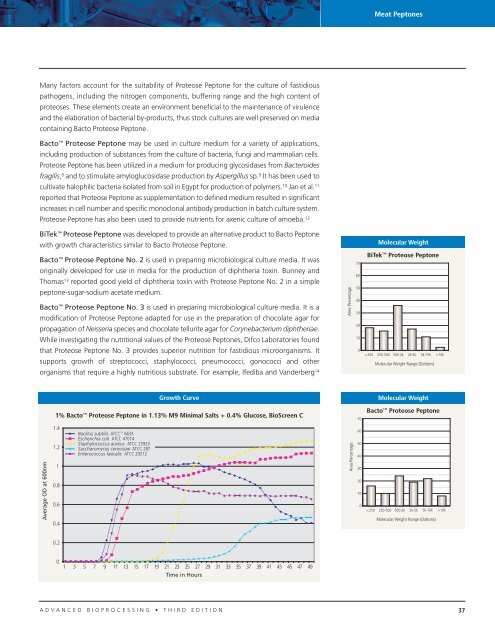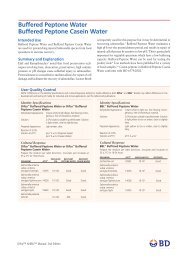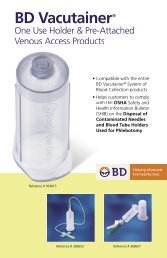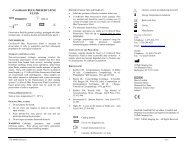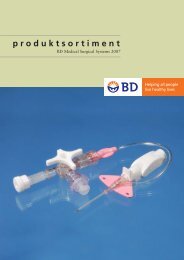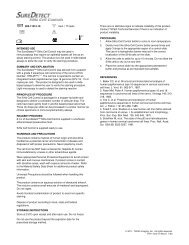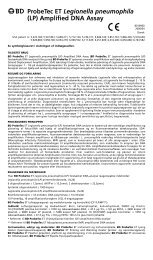Create successful ePaper yourself
Turn your PDF publications into a flip-book with our unique Google optimized e-Paper software.
Many factors account for the suitability of Proteose Peptone for the culture of fastidious<br />
pathogens, including the nitrogen components, buffering range and the high content of<br />
proteoses. These elements create an environment beneficial to the maintenance of virulence<br />
and the elaboration of bacterial by-products, thus stock cultures are well preserved on media<br />
containing Bacto Proteose Peptone.<br />
Bacto Proteose Peptone may be used in culture medium for a variety of applications,<br />
including production of substances from the culture of bacteria, fungi and mammalian cells.<br />
Proteose Peptone has been utilized in a medium for producing glycosidases from Bacteroides<br />
fragilis, 8 and to stimulate amyloglucosidase production by Aspergillus sp. 9 It has been used to<br />
cultivate halophilic bacteria isolated from soil in Egypt for production of polymers. 10 Jan et al. 11<br />
reported that Proteose Peptone as supplementation to defined medium resulted in significant<br />
increases in cell number and specific monoclonal antibody production in batch culture system.<br />
Proteose Peptone has also been used to provide nutrients for axenic culture of amoeba. 12<br />
BiTek Proteose Peptone was developed to provide an alternative product to Bacto Peptone<br />
with growth characteristics similar to Bacto Proteose Peptone.<br />
Bacto Proteose Peptone No. 2 is used in preparing microbiological culture media. It was<br />
originally developed for use in media for the production of diphtheria toxin. Bunney and<br />
Thomas13 reported good yield of diphtheria toxin with Proteose Peptone No. 2 in a simple<br />
peptone-sugar-sodium acetate medium.<br />
Bacto Proteose Peptone No. 3 is used in preparing microbiological culture media. It is a<br />
modification of Proteose Peptone adapted for use in the preparation of chocolate agar for<br />
propagation of Neisseria species and chocolate tellurite agar for Corynebacterium diphtheriae.<br />
While investigating the nutritional values of the Proteose Peptones, Difco Laboratories found<br />
that Proteose Peptone No. 3 provides superior nutrition for fastidious microorganisms. It<br />
supports growth of streptococci, staphylococci, pneumococci, gonococci and other<br />
organisms that require a highly nutritious substrate. For example, Ifediba and Vanderberg14 Average OD at 600nm<br />
1.4<br />
1.2<br />
1<br />
0.8<br />
0.6<br />
0.4<br />
0.2<br />
0<br />
Bacillus subtilis ATCC 6633<br />
Escherichia coli ATCC 47014<br />
Staphylococcus aureus ATCC 25923<br />
Saccharomyces cerevisiae ATCC 287<br />
Enterococcus faecalis ATCC 29212<br />
Growth Curve<br />
1% Bacto Proteose Peptone in 1.13% M9 Minimal Salts + 0.4% Glucose, BioScreen C<br />
1 3 5 7 9 11 13 15 17 19 21 23 25 27 29 31 33 35 37 39 41 43 45 47 49<br />
Time in Hours<br />
ADVANCED BIOPROCESSING • THIRD EDITION<br />
Area Percentage<br />
Area Percentage<br />
70<br />
60<br />
50<br />
40<br />
30<br />
20<br />
10<br />
0<br />
70<br />
60<br />
50<br />
40<br />
30<br />
20<br />
10<br />
0<br />
Meat Peptones<br />
Molecular Weight<br />
BiTek Proteose Peptone<br />
10k<br />
Molecular Weight Range (Daltons)<br />
Molecular Weight<br />
Bacto Proteose Peptone<br />
10k<br />
Molecular Weight Range (Daltons)<br />
37


